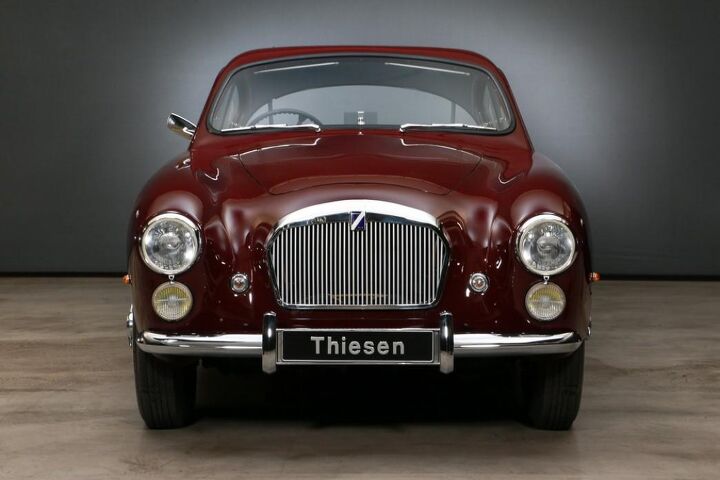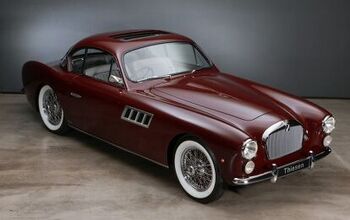Rare Rides: The 1954 Talbot-Lago T26 Grand Sport Coupe - Supreme Elegance (Part I)

Talbot’s history was a difficult one, fraught with adversity. Yet during the company’s earlier iterations it produced beautiful, luxurious cars like today’s Rare Ride. It’s a T26 Grand Sport coupe, from 1954.
What became Talbot started out as Automobiles Darracq, a company founded by businessman Alexandre Darracq in 1896. The firm produced successful racing and passenger cars, but by 1912 its owner wanted out of the business. Assets were sold, and Darracq continued producing cars in France under new management.
The company’s second owners fancied an identity change, and in 1922 the company took the Automobiles Talbot name. Darracq was phased out of the passenger car line, but the name recognition was kept on racing vehicles, now called Talbot-Darracq. Like all automotive firms, Talbot was hit hard by the Great Depression, forcing the company to seek new management in a bid to get them through lean years.
Antonio Lago, an Italian-British businessman and engineer, came aboard to turn things around. However, the ask was too high: Talbot folded in 1934 following a declaration of bankruptcy. But Mr. Lago was still interested in the firm he’d just failed, and ended up purchasing the assets while the company was in receivership.
In 1935, new entity Talbot-Lago continued making its old line of cars, but shortly thereafter new models trickled in to replace the old guard. Through the late Thirties, Lago introduced three new touring cars, and a couple of sports coupes as well. Clever with its engineering, Talbot-Lago created 13 different model offerings from four different chassis lengths.
After World War II, Talbot-Lago headed even further upmarket, with large, luxury cars joining the ranks of the racing cars the company built from the outset. With its new offerings, Talbot competed against the likes of Delage, Hotchkiss, and Delahaye.
Talbot continued at a slow and steady pace with its car production, changing up its styling circa 1952 when it adopted a Ponton style for its volume offerings (the Baby and Record). But the underpinnings were old, and though the new bodies added extra weight, they carried on with the same engines as the lighter outgoing models.
The company was in a financial decline, but there was one car spared from any cost cutting: the T26 Grand Sport. Next time, we’ll take a look at the rarest version of the company’s rare coupe, appearing shortly before the brand’s demise.
[Images: seller]

Interested in lots of cars and their various historical contexts. Started writing articles for TTAC in late 2016, when my first posts were QOTDs. From there I started a few new series like Rare Rides, Buy/Drive/Burn, Abandoned History, and most recently Rare Rides Icons. Operating from a home base in Cincinnati, Ohio, a relative auto journalist dead zone. Many of my articles are prompted by something I'll see on social media that sparks my interest and causes me to research. Finding articles and information from the early days of the internet and beyond that covers the little details lost to time: trim packages, color and wheel choices, interior fabrics. Beyond those, I'm fascinated by automotive industry experiments, both failures and successes. Lately I've taken an interest in AI, and generating "what if" type images for car models long dead. Reincarnating a modern Toyota Paseo, Lincoln Mark IX, or Isuzu Trooper through a text prompt is fun. Fun to post them on Twitter too, and watch people overreact. To that end, the social media I use most is Twitter, @CoreyLewis86. I also contribute pieces for Forbes Wheels and Forbes Home.
More by Corey Lewis
Latest Car Reviews
Read moreLatest Product Reviews
Read moreRecent Comments
- MaintenanceCosts Nobody here seems to acknowledge that there are multiple use cases for cars.Some people spend all their time driving all over the country and need every mile and minute of time savings. ICE cars are better for them right now.Some people only drive locally and fly when they travel. For them, there's probably a range number that works, and they don't really need more. For the uses for which we use our EV, that would be around 150 miles. The other thing about a low range requirement is it can make 120V charging viable. If you don't drive more than an average of about 40 miles/day, you can probably get enough electrons through a wall outlet. We spent over two years charging our Bolt only through 120V, while our house was getting rebuilt, and never had an issue.Those are extremes. There are all sorts of use cases in between, which probably represent the majority of drivers. For some users, what's needed is more range. But I think for most users, what's needed is better charging. Retrofit apartment garages like Tim's with 240V outlets at every spot. Install more L3 chargers in supermarket parking lots and alongside gas stations. Make chargers that work like Tesla Superchargers as ubiquitous as gas stations, and EV charging will not be an issue for most users.
- MaintenanceCosts I don't have an opinion on whether any one plant unionizing is the right answer, but the employees sure need to have the right to organize. Unions or the credible threat of unionization are the only thing, history has proven, that can keep employers honest. Without it, we've seen over and over, the employers have complete power over the workers and feel free to exploit the workers however they see fit. (And don't tell me "oh, the workers can just leave" - in an oligopolistic industry, working conditions quickly converge, and there's not another employer right around the corner.)
- Kjhkjlhkjhkljh kljhjkhjklhkjh [h3]Wake me up when it is a 1989 635Csi with a M88/3[/h3]
- BrandX "I can charge using the 240V outlets, sure, but it’s slow."No it's not. That's what all home chargers use - 240V.
- Jalop1991 does the odometer represent itself in an analog fashion? Will the numbers roll slowly and stop wherever, or do they just blink to the next number like any old boring modern car?



































Comments
Join the conversation
Just lovely.
That is simply a beautiful, stunning car.